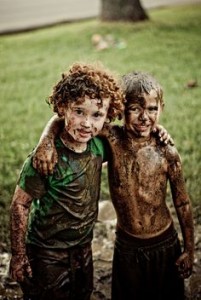Taking risks is part of normal childhood play, at least it should be according to the experts.
So what is risky play?
Sandseter (2007) identified risky play as incorporating the following:
- play involving heights, e.g. climbing a tree
- play involving speed, e.g. rolling down a slope
- play involving s tools, e.g. using a hammer, wood and nails to build something;
- play involving dangerous elements, e.g. splashing in water
- rough and tumble play, e.g. tackling
- play where children can get lost, e.g. hide ‘n seek.
 Adults may find it useful to keep these categories in mind when observing their children in play as it can help to normalise the natural thrill-seeking behaviours children engage in.
Adults may find it useful to keep these categories in mind when observing their children in play as it can help to normalise the natural thrill-seeking behaviours children engage in.
In saying that, of course we do not advocate dangerous play or play that could cause injury or be traumatic for a child or their parent. While children tend to approach risk in play progressively as they mature cognitively, physically, socially and emotionally, adults still need to support children in staying reasonably safe by helping them take age-appropriate risks in order to build skills.
Decisions about the risk of engaging in any play activity should take into account the risk involved, the benefits which may be derived from it, and the risks of not engaging in it, related to the child’s holistic wellbeing (Hewitt-Taylor & Heaslip, 2012).
